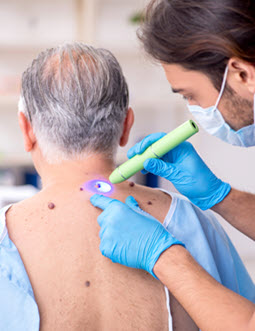Consult a trusted dermatologist to address your dermatology needs.
Consult a trusted dermatologist to address your dermatology needs.
Blog Article
Navigating Skin Cancer Therapy: The Necessary Function of Mohs in Modern Dermatology Practices
Skin cancer cells, a difficult medical diagnosis, typically leaves patients grappling with many therapy choices. As we explore the complexities of this treatment, one will appreciate its essential duty in skin cancer treatment.
Recognizing Skin Cancer: Types and Threats
Skin cancer, a potentially dangerous malady, is much more prevalent than lots of people realize. This disease, brought on by the unchecked growth of unusual skin cells, mostly arises from DNA damages due to exposure to the sun and ultraviolet (UV) light. There are 3 major sorts of skin cancer: Basal cell carcinoma, Squamous cell carcinoma, and Melanoma. While the previous 2 are much less dangerous and make up the majority of diagnosed situations, melanoma is the most hazardous. It makes up just concerning 1% of skin cancer cells instances yet causes the vast majority of skin cancer deaths - skin cancer. Threat variables consist of fair skin, history of sunburn, excessive sun exposure, living at high altitudes or near the equator, having numerous moles, a household history of skin cancer, and weakened immune system.
What Is Mohs Surgery and Just How It's Transforming Skin Cancer Cells Therapy
Regardless of the numerous treatments currently offered for skin cancer cells, Mohs surgical procedure stands out as a groundbreaking and highly effective service. Named after Frederic E. Mohs, the doctor that created the treatment, Mohs surgery is a precise surgical technique made use of to treat skin cancer. This level of precision, integrated with the capability to spare as much healthy tissue as possible, is reinventing skin cancer cells treatment.
The Advantages of Mohs Surgical Treatment Over Standard Skin Cancer Cells Treatments
Building on the cutting-edge nature of Mohs surgery, it's imperative to consider its many benefits over conventional skin cancer cells treatments. Unlike conventional treatments, Mohs provides a greater treatment rate, commonly getting to 99% for novice therapies and 94% for recurrent cancers. In addition, it minimizes damage to healthy and balanced skin, leading to much less scarring and boosted cosmetic results.
The Treatment of Mohs Surgical Procedure: What to Expect During the Process

Possible Side Effects and Post-Operative Treatment of Mohs Surgery
Going through Mohs surgery, like any type of various other surgical treatment, involves possible adverse effects that people ought to recognize. Common adverse effects consist of discomfort, wounding, and swelling at the surgery site. These are normally temporary and convenient with over the counter discomfort medication and ice packs. In rare instances, people may experience infection, bleeding, or an allergy to the neighborhood anesthetic. Post-operative care is important to healing and lessening side effects. This normally involves maintaining the wound tidy and dry, taking recommended drugs, and staying clear of strenuous activities. People need to also attend all follow-up visits for injury care and tracking. In many cases, extra treatments might be required to make certain full elimination of the malignant cells. Sticking to these post-operative treatment standards can considerably browse around here boost recuperation and results.
Verdict

Report this page